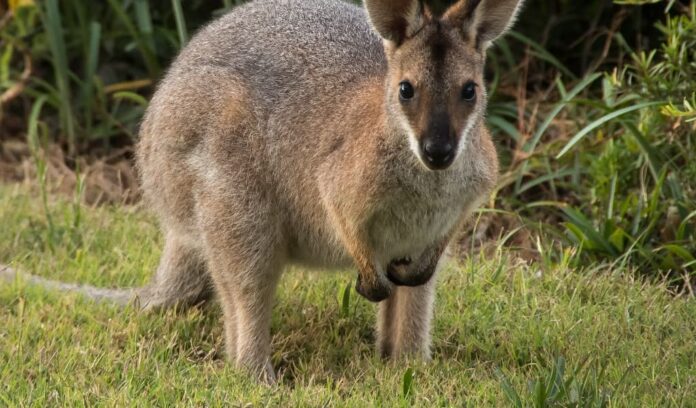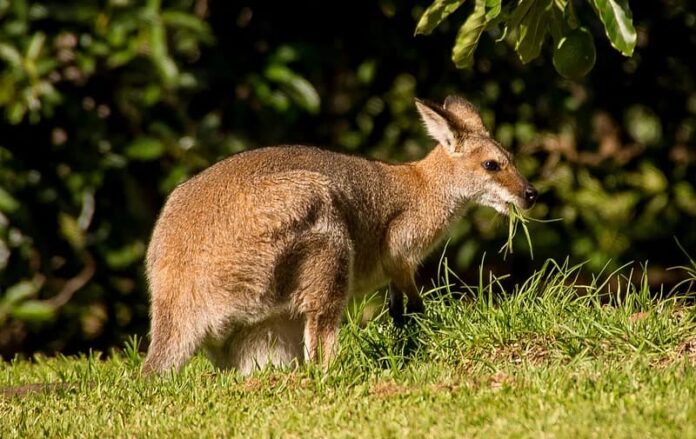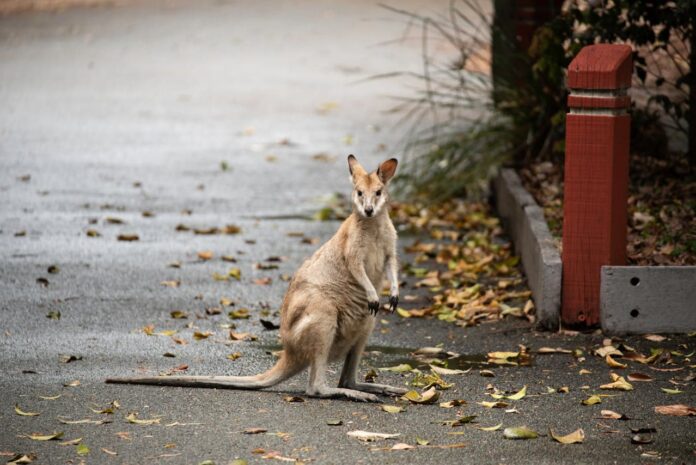Wallaby shares almost the same appearance as the kangaroo since they are from the same family. The term wallaby refers to any macropod that is smaller than a kangaroo, and this is how you identify them. There are 9 wallaby species in total, but one of them has already extinct from the world. We are going to discuss all species later, and we will only focus on the main information about wallabies today. Don’t forget to let us know if there is anything else that you would like to add.
1Appearance

Wallabies are almost identical to kangaroos but smaller, so recognizing one at a glance can be challenging. At the same time, their sizes are also different in various species as well. The size of a wallaby can be as small as a rabbit to almost 2 meters (6.5 feet) from head to tail. A wallaby has soft and woolly fur that can be brown, gray, red, or almost black. As marsupials, each female wallaby has a pouch that functions as a nursery for her newborn that is often lighter in color. The interesting thing about them is that they have powerful hind legs just like their cousin kangaroos. Wallabies use these hind legs to bound at high speeds and jump great heights in their daily activities. Along with that, those strong legs are also helpful when it comes to administering vigorous kicks on enemies and predators.
When in danger, a wallaby will thump its feed, kick its hind legs, and emit a hoarse noise to alert other members. Legs are not the only powerful limbs that they have, their large and long tails also play a part. Wallabies use their big tails to maintain balance and to hold themselves in a sitting posture. On top of that, the tails aid them to deliver powerful kicks when the males battle each other. This method is also useful when they have to defend themselves against predators when they are in danger. How about their T-Rex forelimbs? Wallabies have short arms that they use primarily for feeding, can’t fight with those arms, aight mate? Their appearances are often a little different from one another due to adaptation to their habitats. For example, rock wallabies have modified feet that can grip onto stone while other wallaby species lack those.
2Behavior

The fascinating thing about these marsupials is that they are crepuscular, meaning they are most active around dusk and down. During those active times, wallabies are solitary so they look for food by themselves. On some occasions, they are also spotted forage for food in a group of up to 50 individuals called “mob”. Wallabies will gather in the breeding season which is between January and February. A mother wallaby gives birth to a single joey that is tiny and undeveloped after a gestation period of 28 days. The joey then crawls up into its mother’s pouch where it is cared for and nurtured until it is fully developed. This can be a couple of months, and young wallabies are actually larger than kangaroos. Joeys will leave the pouch when they are around 1 year old but often jump back in when danger approaches.
3Feeding & Habitat

Being strong and all, wallabies are herbivores so they feed on plants such as grasses, leaves, and sedges. Besides those, wallabies also eat ferns, herbs, and various types of fruit depending on their habitats. Thanks to their long jaws and big flat teeth, chewing their meal is not a big deal for them at all. As you can see, a wallaby has an elongated face which leaves plenty of jaw room for the teeth. Together, it is able to chew and extract all the nutrients that it needs from its food efficiently every time. This is why some species don’t live in areas near freshwater supplies since they can extract plant juices while eating.
Wallabies are native to and widely distributed across Australia, and many of them live in heavily timbered, remote, or rugged areas. These marsupials are also found on the island of New Guinea and nearby islands although the population there is less. Apart from these places, they have been introduced to other parts of the world such as New Zealand and the UK. There are about 30 wallaby species, and their natural habitats are different depending on the species; hence group names. Some prefer brush and forest areas while others enjoy living in rocky, shrub, or swamp areas. This is why there are different wallaby species based on where they live such as brush wallabies, rock wallabies, etc.
4Predators & Threats
Despite having fast and powerful, wallabies still have natural predators such as dingos, dogs, feral cats, foxes, and Tasmanian devils. Along with those, wedge-tailed eagles and other raptors are the predators and threats to the joeys. Humans are also one of the threats due to increased interaction which often leads to violence. Wallabies can defend themselves by biting and kicking, and humans sometimes will kill them in such quarrels. Humans will also hunt wallabies for their fur and meat although it is not common now as it used to be. The introduction of non-native species like cattle, goats, and sheep also threatens them when it comes to food and resource competition.
The real threat to the wallaby population is habitat loss due to European settlement and other forms of development. People clear native bushes to make room for agricultural land and grazing, and that affects the wallabies greatly. At the same time, further land development wiped out a substantial amount of diversity within their natural habitats. Plus with climate change, their number starts to decrease from day to day in the past few years. Among 30 species, several species are either endangered or threatened while at least 5 have already been extinct.
Related Post: Things You Don’t Know About Wombats




